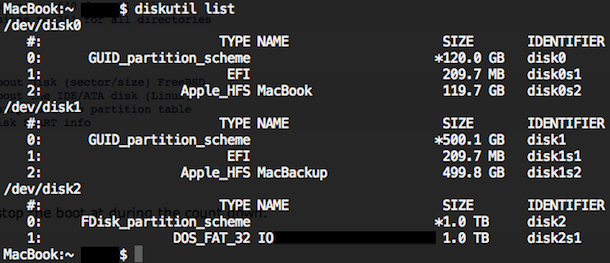Power Mac G4 12-inch Mac OS X Install Disc 2Z691-5214-A Disc Version 1.0 - Mac OS 10.3.7. By PowerBook G4. 5.0 out of 5 stars 1. DVD-ROM Currently unavailable. PowerBook G4 15-inch and 17-inch Mac OS X Install Disk v.10.3.3. By Apple Computers. 5.0 out of 5 stars 1. The DOS fdisk program can be used to divide space on the disk into parti- tions and set one active. This fdisk program serves a similar purpose to the DOS program. When called with no special flags, it prints the MBR partition table of the specified device, i.e., # fdisk fd0 Disk: fd0 geometry: 80/2/18 2880 sectors Offset: 0 Signature: 0xAA55. In the Disk Utility app on your Mac, select a volume in the sidebar, then click the Partition button. In the pie chart, select the partition you want to delete, then click the Delete button. The partition is removed, reformatted, and all free space is assigned to the previous partition.
Partition table manipulator for Darwin UFS/HFS/DOS.


In order for the BIOS to boot the kernel, certain conventions must be adhered to. Sector 0 of a bootable hard disk must contain boot code, an MBR partition table, and a magic number (0xAA55). These MBR partitions (also known as BIOS partitions) can be used to break the disk up into several pieces. The BIOS loads sector 0 of the boot disk into memory, verifies the magic number, and begins executing the code at the first byte. The normal DOS MBR boot code searches the MBR partition table for an ``active' partition (indicated by a `*' in the first column), and if one is found, the boot block from that partition is loaded and executed in place of the original (MBR) boot block.
The automatic calculation of starting cylinder etc. uses a set of figures that represent what the BIOS thinks is the geometry of the drive. These figures are by default taken from the in-core disklabel, or values that /boot has passed to the kernel, but fdisk gives you an opportunity to change them if there is a need to. This allows the user to create a bootblock that can work with drives that use geometry translation under a potentially different BIOS.
If you hand craft your disk layout, please make sure that the OpenBSD partition starts on a cylinder boundary. (This restriction might be changed in the future.)
Editing an existing partition is risky, and can cause you to lose all the data in that partition.
You should run this program interactively once or twice to see how it works. This is completely safe as long as you answer the `write' questions in the negative.
There are subtleties fdisk detects that are not explained in this manual page. As well, chances are that some of the subtleties it should detect are being steamrolled. Caveat Emptor.
Examples
List the current partitions:
$ sudo fdisk /dev/rdisk0
'When I'm reading material, if I'm a little bit afraid of a part and I'm willing to admit that to myself, then I'll do it, definitely. If I'm worried about being able to do it, to get it - I absolutely just love it' - Jack Lemmon

Related macOS commands:
Gpt Fdisk For Mac Os X
pdisk(8)
Some rights reserved
It started because disk drive random eject, detail on this thread:
http://discussions.apple.com/message.jspa?messageID=13106931#13106931
Now one of my partition didn't mount. I try to fix this using disk utility -repair disk function- and disk warrior, both not succeed. Then I want to try repair it using Ubuntu live cd, but before that, some tutorial that I found in someone blog says I must disable journaling. It success at other 2 partition but the one that I need to repair wasn't return any dialog after about 2 minutes, that made me close Terminal. Disk1s2 is the problem.
My assumption after some googling, my partition table is messed up and need repairing. I found enlightenment when found tesdisk http://www.cgsecurity.org/wiki/TestDisk . Summaries from what I read there, I should able repair it after run test disk to analyze then using pdisk function in terminal to restore or fix the partition.
What is this mean CHS and LBA didn't match? I assume this value is needed to be repaired.
From the explanation on that site, 'use pdisk to recreate the Mac partition map using the values given by TestDisk.' Then I realized my partition scheme isn't Apple Partition Map. Refer to image screenshoot #1 it written Fdisk partitonscheme or better known as MBR. Pdisk only support APM, and so far tutorial I found only write about pdisk:
http://perrohunter.com/read/30/repair-a-mac-os-x-hfs-partition-table
CMIIW but fdisk -e, edit function probably able to insert this new values on MBR. I just don't know how to do this.
So is there anyone in that able for *helping me to understand how I could edit this value using fdisk -e?* Please don't refer me to http://developer.apple.com/library/mac/#documentation/Darwin/Reference/ManPages/ man8/fdisk.8.html . I've read that and still confused.
If possible using step by step explanation, similar with perrohunter pdisk. I'm not really expert with CLI.
Re-format the disk is not solution.
----
As for now my external drive condition is:
1. Random eject still occur.
2. One partition didn't mount.
3. Diskutil failed to disable journaling. Thus make worrying if fdisk also unable to do the job. But at least I want to give a try.
4. Slow write/read speed even on detected partition.
iMac 7,1 2.0 GHz, Mac OS X (10.6.6)
Mac Fdisk For Os X 10.7
Posted on

